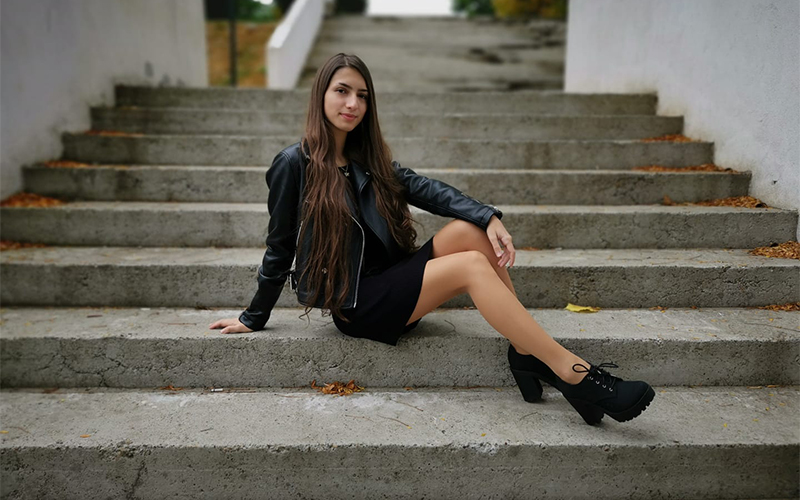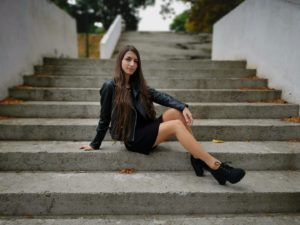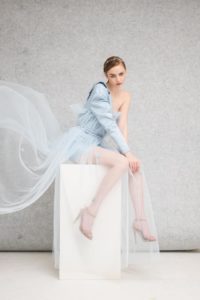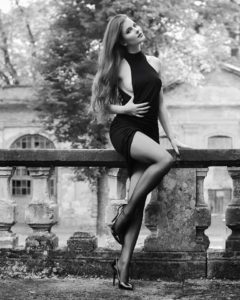
Cavalcando la colonna del tempo – Riding the column of the time
Baricco immagina che qualcuno si sieda sui gradini della propria casa. Nel buio, solo si sarebbero uditi degli strani rumori, come “briciole” avanzate dalla luce diurna, ed ora “affaccendate” per concorrere a “fecondare” in puntualità il “ventre” dell’alba, avente una grandezza planetaria. Una casa ci protegge; ciononostante noi preferiremo “l’ascensione” trasfigurativa… Denisa è stata inquadrata su una scalinata pubblica, e seduta. Contro il grigio del marmo, il nero dell’abbigliamento prova a risaltare. Ai lati dei gradini, addosso al muretto, si sono accumulate le foglie secche. Di poca grandezza, quelle potranno percepirsi come “briciole” di faville per la “fecondità” delle gambe “atletiche”. Ci basterà immaginare lo stile “Fosbury”, ad “arcobaleno” per i marmi “rumorosamente” logori della scalinata. La pelle nuda è protettiva, ma con una tonalità “freddamente” illuminata. Si percepisca in alto il muretto staccato, a “campana” per svegliare con un colpetto la testa di Denisa. In basso, i piedi s’allineano fra di loro, “costruendo”… il “viadotto” dei tacchi.
Baricco imagines that somebody is sitting on the steps of the own house. In the dark, only he could listen strange noises, as “crumbs” left over by the daylight, and now “so busy” to compete in a punctual “fecundation” in regard to the “womb” of the dawn, which has a planetary size. A house protects us; nevertheless we prefer a transfiguration from “an ascension”… Denisa was framed on a public staircase, and sitting. Against the grey of the marble, the black of the clothing tries to stand out. On the sides of the steps, on the little wall, the dry leaves are amassed. Those, having a small size, could be perceived like “crumbs” of the sparks for the “fecundity” of the “athletic” legs. It will be enough for us to imagine a “Fosbury” style, as a “rainbow” for the marbles “noisily” worn out of the staircase. The bare skin is protective, but with a tone “coldly” illuminated. We perceive above a little wall which is detached, as a “bell” to wake up through a tap the Denisa’s head. Below, the feet are aligned each other, “building”… a “viaduct” of the heels.

Per il filosofo Diderot, chi scrive delle donne deve intingere la penna nell’arcobaleno, ed asciugare la pagina con la polvere presa dalle ali di farfalla. Ma quanto dialetticamente la “fuggevolezza” per il corteggiamento si concluderà in una conquista… “lunatica”? Anastasiia è stata inquadrata da seduta, sul cubo. Lo scatto ha le tonalità complessivamente all’immanenza angelica: fra il bianco, il celeste ed il grigio. Immaginiamo la configurazione “a farfalla” del vestito. Ma quanto il “pennino” del braccio destro sarà stato in grado d’intingere, sull’ala “a tavolozza”? Si noti il puntinismo sul muro del fondale. Lo sguardo di Anastasiia è abbastanza secco, provando ad imporsi su di noi. Invece, nessuno saprà mai quanto durerà l’arcobaleno calante a “polvere d’oro”, per il cerchietto sui capelli.
According to the philosopher Diderot, when writing about women, you have to dip the pen in the rainbow, and dry the page with the dust taken by the butterfly wings. But how much dialectically will the “fleetingness” of a courting be concluded with a… “moody” conquest? Anastasiia was framed sitting on the cube. The shot has the tones on the whole in an angelic immanence: between the white, the pale blue and the grey. We imagine the configuration “in butterfly” of the dress. But how much would a “nib” of the right arm be able to dip, on a wing as “a palette”? We note the pointillism on the wall as backcloth. The Anastasiia’s gaze is quite dry, trying to impose itself on us. Instead, nobody will ever know how much the rainbow waning in “gold dust”, from the headband, will last.

Per Moriconi, sul colle costiero di Posillipo la schiuma è marmorea, mentre il verde dell’acqua “stormisce”. Vale pure il mito della Sirena Partenope, disperata perché l’eroe Ulisse resistette alla seduzione del suo canto. Dunque l’idillio del paesaggio può ingannare. Simbolicamente sarà la rotta della balaustra, che ci farà saltare sulla “profondità recondita” d’un desiderio “mai calibrato”. Ariadna ha posato per una fotografia in bianconero. Lei accavalla le gambe, reggendosi ad una balaustra in marmo. Sullo sfondo, si vede un vecchio palazzo, il cui tetto è coperto dalla chioma alberata. Il corpo veramente sinuoso di Ariadna può stordirci, in specie dal fruscio d’una mano sulla pancia (complici le pieghe dell’abito). Il bianconero non si percepisce come idilliaco. Ma una colonna della balaustra è stata rotta. Saltando dall’altra parte, potremo solo sperare in una “spuma” della chioma, se “distratti” dal corpo “burroso”?
According to Moriconi, on the coastal hill of Posillipo the foam is marbled, while the green of the water “moans”. Also the myth of the Parthenope Siren is valid; she was desperate because Ulysses resisted the seduction from her singing. So the idyllic life of a landscape can deceive. Symbolically that will be the breakage of a balustrade, that will lead us to jump on the “recondite profundity” of a desire “never in calibration”. Ariadna posed for a photography in black and white. She overlaps the legs, holding on a marbled balustrade. On the background, we see an old building, whose roof is covered with the foliage. The body really sinuous of Ariadna can stun us, especially from the rustle of a hand on the abdomen (complicit the folds of the dress). The black and white is not perceived as idyllic. However a pillar of the balustrade was broken. Jumping on the other side, could we only hope in a “foam” of the foliage, if we are “distracted” by the “squishy” body?

Bibliografia consultata – Annotated bibliography:
A. BARICCO, City, Feltrinelli, Milano 2015
C. WINN & D. KUIZENGA, Women writers in pre-revolutionary France: strategies of emancipation, Garland, New York 1997
G. SCOGNAMIGLIO, L’universo poetico di Moriconi, Liguori, Napoli 2004, pp. 60-65
Nota biografica sugli artisti recensiti – Biographical sketch about the five artists:
La modella Denisa Lepadatu viene da Galati (Romania). Lei è soprattutto scrittrice, di poesie e romanzi. A Denisa piace molto la matematica. Lei è studentessa di chimica e biologia.
The model Denisa Lepadatu comes from Galati (Romania). She is principally a writer, of poems and novels. Denise likes very much the mathematics. She is a student of chemistry and biology.
La modella Anastasiia Streltsova comes from Sachty (Russia). Lei ha studiato Comunicazione ed informatica.
The model Anastasiia Streltsova comes from Sachty (Russia). She studied Communication and computer science.
La modella Ariadna Majewska viene da Poznan (Polonia). Lei è anche fotografa, e soprattutto una fashion blogger seguitissima a livello mondiale.
The model Ariadna Majewska comes from Poznan (Poland). She is also a photographer, and principally a fashion blogger very popular in all the world.
http://www.ari-maj.com/
P.S. Avvertenza – Instructions
Il fotografo di Denisa Lepadatu ha richiesto di restare anonimo.
The Denisa Lepadatu’s photographer requested to remain in disguise.
Per Anastasiia Streltsova, è stato impossibile risalire con esattezza a chi l’avesse fotografata, professionalmente.
For Anastasiia Streltsova, was impossible going back to who exactly shot her, in a professional way.
Il fotografo di Ariadna Majewska ha richiesto di restare anonimo.
The Ariadna Majewska’s photographer requested to remain in disguise.

+ Non ci sono commenti
Aggiungi